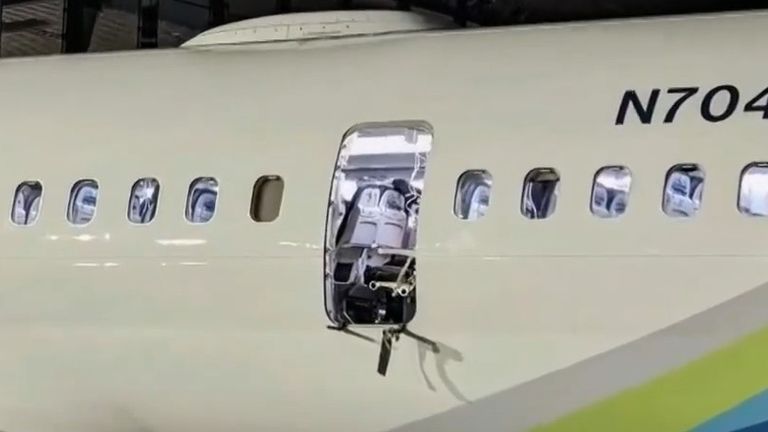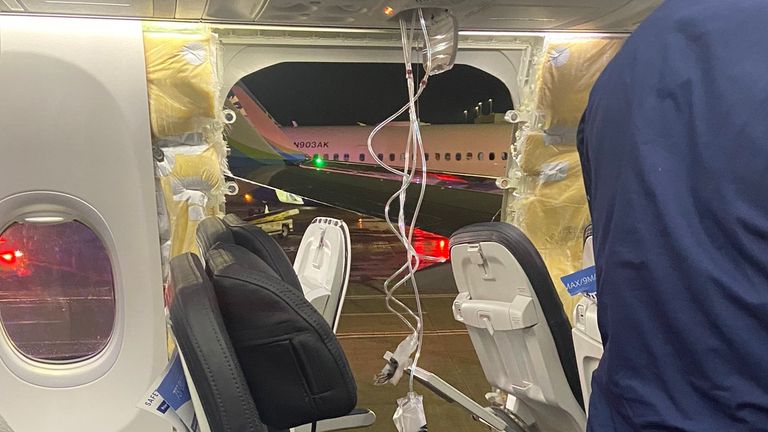Alaska Airlines plane had pressurisation warnings before mid-air blowout
Pilots had reported pressurisation warnings on three earlier flights of the same plane involved in a mid-air blowout, investigators have said.
Alaska Airlines was forced to perform an emergency landing on Friday after a door plug was torn off of the Boeing 737 Max 9 plane flying 171 passengers from Portland in Oregon, to Ontario in California.
The incident happened after the auto-pressurisation fail light lit up on the same aircraft on 7 December last year and 3 and 4 January this year.
After those warnings, the airline chose to ban the aircraft from making long flights over water to Hawaii, in case it needed to turn back to an airport, the National Transportation Safety Board (NTSB) said.
But it is unclear if there is any connection between those incidents and the accident, NTSB chair Jennifer Homendy said.
Read more on this story:
Passenger says ordeal was ‘jarring and disorienting’
She also described a harrowing picture of the incident, with the 27kg panel blowing off the side of the aircraft and causing rapid depressurisation inside the plane, which had not reached cruising altitude.
The force of the decompression led to the cockpit door being blown open while the flight crew could not communicate with the pilots.
“They heard a bang,” Ms Homendy said of the flight crew, adding a quick-reference laminated checklist was sucked out of the hole, while the first officer lost her headset.
“Communication was a serious issue… it was described as chaos.”
The door plug – where the hole was made – has now been recovered by a school teacher only named as Bob from Cedar Hills in Portland.
There were also four unaccompanied minors on the flight, Ms Homendy said, with “heroic” flight attendants ensuring they had their oxygen masks on.
Missing voice recorder data
To compound communication issues, the cockpit voice recorder (CVR) had no data as it was not retrieved within two hours, when recording restarts and previous data is erased.
“It’s a very chaotic event, the circuit breaker for the CVR was not pulled, the maintenance team went out to get it, but it was right at about the two-hour mark,” Ms Homendy said.
“If that communication is not recorded, that is unfortunately a loss for us… that information is key not just for our investigation but for improving aviation safety.”
In response to the mid-air incident, the US Federal Aviation Administration (FAA) grounded 171 Boeing 737 Max 9 planes to run inspections, which has caused cancellations to pile up for passengers.
Alaska Airlines said it cancelled 170 flights on Sunday and a further 60 on Monday, with more expected this week and other airlines also affected.
Reports were ‘fully evaluated’
Responding to the reports on the warning lights, Alaska Airlines said aircraft pressurisation system write-ups are typical in commercial aviation operations with large planes.
“In every case, the write up was fully evaluated and resolved per approved maintenance procedures and in full compliance with all applicable FAA regulations,” the airline said.
Read more:
What next for flights and 737 aircraft, according to experts
Ms Homendy had previously said it was “very lucky” the accident wasn’t far worse.
She revealed no one was sat in the seats immediately next to the affected fuselage – and because the plane had not reached cruising altitude, passengers and crew were not moving around the cabin.
No one was injured, and the plane landed safely back in Portland.

